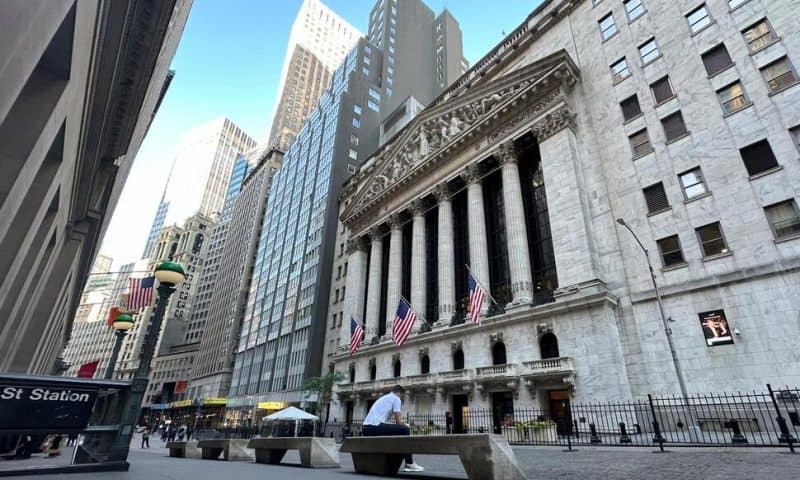Another slide for Wall Street heavyweight Nvidia kept U.S. indexes mixed, even as the majority of stocks rallied
NEW YORK — Another slide for Wall Street heavyweight Nvidia kept U.S. indexes mixed Monday, even as the majority of stocks rallied.
The S&P 500 slipped 0.3% to pull further from its record set last week. The drops for Nvidia and other winners of Wall Street’s artificial-intelligence boom pulled the Nasdaq composite down 1.1%, while the Dow Jones Industrial Average rose 260 points, or 0.7%.
Stocks of oil-and-gas companies were among the market’s strongest, as seven out of every 10 stocks in the S&P 500 rose. Exxon Mobil climbed 3%, and oilfield services provider SLB gained 4% as oil prices hung near their highest levels since April.
Financial companies were also strong. JPMorgan Chase added 1.3%, and Wells Fargo climbed 1.6% ahead of results coming later in the week for tests by the Federal Reserve of how big banks would fare in a recession.
But declines for a handful of high-profile stocks offset all of those gains, and the spotlight shone brightest on Nvidia’s 6.7% tumble. It was a third straight drop for the chip company, which had rocketed 1,000% higher since the autumn of 2022.
Nearly insatiable demand for Nvidia’s chips to power artificial-intelligence applications have been a big reason for the U.S. stock market’s run to records recently, even as the economy’s growth slows under the weight of high interest rates. But the AI boom has been so frenzied that it’s raised worries about a possible bubble in the stock market and too-high expectations among investors.
Nvidia’s stock has been receding since it briefly overtook Microsoft as Wall Street’s most valuable last week, and it’s down nearly 13% in just three days. Because Nvidia has become so massive in size, the movements for its stock carry extra weight on the S&P 500 and other indexes. It was the heaviest weight by far on the S&P 500 Monday.
Other AI beneficiaries also gave up some of their fantastic gains. Super Micro Computer dropped 8.6% to shave its gain for the year so far back below 200%, down to 190.9%.
Such a rotation among stocks could actually be a healthy sign for the market, as long as it can stay close to its records. Market watchers have been worried to see just Nvidia and a handful of other companies responsible for much of the S&P 500’s returns recently. They would prefer a market where many stocks are participating in the gains.
RXO jumped 23% after it agreed to buy the Coyote Logistics freight brokerage business from UPS for nearly $1.03 billion. RXO said the deal will make it North America’s third-largest provider of brokered transportation. UPS, which bought Coyote in 2015 for $1.8 billion, rose 1.5%.
Under Armour swung from an early loss to a gain of 2% after saying it agreed to pay $434 million to settle charges raised by shareholders related to its accounting and sales practices. The shoe and athletic wear company denied any wrongdoing in the settlement, but it also agreed to separate the roles of chairman and CEO for at least three years.
All told, the S&P 500 fell 16.75 points to 5,447.87. The Dow rose 260.88 to 38,411.21, and the Nasdaq composite dropped 192.54 to 17,496.82.
In the bond market, Treasury yields eased a bit. The yield on the 10-year Treasury fell to 4.23% from 4.26% late Friday.
It’s been mostly falling since topping 4.70% in late April, which has relaxed the pressure on the stock market. Yields have sunk on hopes that inflation is slowing enough to convince the Federal Reserve to cut its main interest rate later this year.
The Fed has been keeping the federal funds rate at the highest level in more than 20 years, hoping to grind down on the economy just enough to get inflation under control.
Fed officials may be underappreciating just how much the U.S. economy is slowing, according to economists at UBS led by Abigail Watt. They see growth slowing to below a 2% annualized rate in the first half of 2024, down from 3.1% growth in the fourth quarter of 2023 from a year earlier.
The UBS economists say U.S. households in the bottom 40% of the country for income are burning through their savings after depleting the cushions they had built through the pandemic. That could further slow retail sales, which have been up and down as companies highlight how lower-income customers are often struggling to keep up.
Wall Street is actually hoping for a slowdown in the economy, one that will take upward pressure off inflation and push the Federal Reserve to cut rates. Goldman Sachs economist David Mericle said a rate cut could happen as soon as September if inflation reports like the one coming up on Friday turn out as expected.
The Fed just needs to make sure it cuts interest rates at the right time. If it waits too long, the economy’s slowdown could careen into a recession. If it’s too early, inflation could reaccelerate.
In stock markets abroad, indexes rose across much of Europe after mostly falling in Asia.

